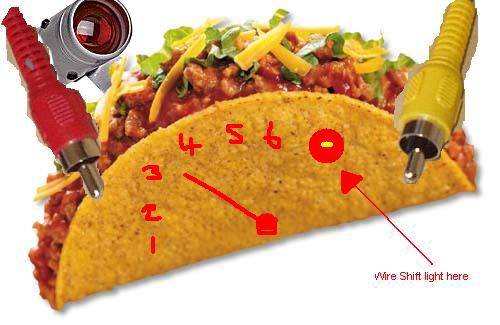There's probably another related reason it doesn't work. In std form, that wire goes from ignition to coil. And the other side of the coil goes to the dizzy, so when the points open, the circuit on the ignition side of the coil doesn't flow current. It's on and off on and off, and somehow (and I forget how exactly) the tacho works off this pulsing, being powered by it rather than having a separate power feed and the coil 'pickup' wire being used as a switch/signal, not as the main power.
Now if you convert to electronic ignition, the coil itself is still switched on and off (a bit like how the points dizzies do it) but when the current isn't flowing through the coil itself (when the electronic ignition module/circuit opens the circuit, the equivalent of points opening) - well whilst the coil itself won't have power/current flowing through the low voltage side, well that wire from the ignition switch, through the tacho and on to the coil - well that will still see current at all times, as even when it opens the coil circuit, the electronic module is still being powered all the while.
So, what to do. Well, I haven't tried it but I believe this would work. ANd it is simply this - cut the wire (in a location where it is easy to access/repair if need be) that goes from the ignition through the tacho and on to the coil. Bypass it and run the wire directly from the ignition switch on terminal right to the coil positive. hook the electonic ign positive to the coil positive (no surprises there) but instead of the 'other' electronic dizzy wire going direct to the coil negative, well you run a longer wire and run THAT wire into/through the tacho and then back out to the coil negative. Because THAT wire will see pulsing, and at the same rate as the original wiring would display it (though to be fair it might be at a higher voltage)
Anyhoo - that will give the tacho the signal in the form it is originally designed to receive it. So it should work. But as mentioned, the voltage may be higher. I don't know if this will have any effect on the tacho - or damage it or what.
I've been 'gonna' do my own electronic ignition conversion for a while now, and was planning to do the above mentioned wiring mods. I'll try and get to it next weekend (sat/sun 14/15 april) and I'll report back here if the tacho works, doesn't work, melts, files a restraining order, or whatever happens :)
If it doesn't work I've been looking at 2 alternatives. The first is simply an aftermarket tacho - maybe mounted on the column, or perhaps even sourcing a spare dash and modifying it to put the aftermarket tacho into the spot the factory tacho goes. The other option I've given thought to (and might even consider doing even if the factory tacho is made to work with the electronic ignition). And that other option is a shiftlight, but more specifically one that has multiple leds - a little bit like some formula 1 steering wheel mounted tach/indicators. You can set them so that the if your redline was say 6500rpm, the first of the lights would light up at about 5500, then another at 5600 and so on, till they are all on and flashing by 6500. That way you don't need to really know exactly what the rpm is, you just respond to the light activation and shift at the optimal moment, with sufficient warning that the shift rpm is approaching rapidly. Anyway - this shiftlight setup - here's the one I'm considering :
http://www.ecliptech.com.au/http://www.ecliptech.com.au/index.php ... =article&id=59&Itemid=109Apart from those mentioned benefits, they are also a lot less blatant, and can be discretely installed where you want. They'll attract less attention from low life thieves looking for a quick score, selling a monster tacho at the local pawnbrokers, and less attention from the boys in blue who might otherwise make the call 'monster tacho = hoon, and must be put off the road at all cost before they kill 2 million people) (and for the record I'm not mad at the police at all, it's the politicisns with their ravenous attitude to car enthusiasts that are ultimately who brought this era in)









 Transfer
Transfer










